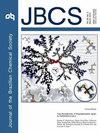A New Molecularly Imprinted Polymer for In-Tube SPME/UHPLC-MS/MS of Anandamide in Plasma Samples
IF 1.3
4区 化学
Q3 CHEMISTRY, MULTIDISCIPLINARY
引用次数: 0
Abstract
Parkinson’s disease is a neurodegenerative disorder characterized by progressive loss of dopaminergic neurons. There is substantial evidence that the endocannabinoid system modulates the dopaminergic activity in the basal ganglia, a forebrain system that integrates cortical information to coordinate motor activity regulating signals. In this article, a fused-silica capillary with a molecularly imprinted polymer was developed for in-tube solid-phase microextraction of the endocannabinoid anandamide in plasma samples from Parkinson’s disease patients and further analysis by ultra-high-performance liquid chromatography with tandem mass spectrometry. The molecularly imprinted polymer capillary presented recognition sites with complementary shape, size, and functionality to anandamide. Scanning electron micrographs and Fouriertransform infrared spectra illustrated the physical and chemical modification of the printed and non-printed capillary surface. The in-tube solid-phase microextraction ultra-high-performance liquid chromatography with tandem mass spectrometry method presented a linear range from 0.1 to 20 ng mL-1, precision with coefficient of variation values ranging from 1.2 to 13%, and relative standard deviation accuracy ranging from -3.6 to 7.5%. The method developed herein can adequately determine anandamide in plasma samples from Parkinson’s disease patients. By applying the standard addition approach, the anandamide plasmatic concentration in these samples was found to range from 0.2 to 0.4 ng mL-1.一种新型分子印迹聚合物用于血浆样品中阿南达胺的管内SPME/UHPLC-MS/MS分析
帕金森氏病是一种以多巴胺能神经元进行性丧失为特征的神经退行性疾病。有大量证据表明,内源性大麻素系统调节基底神经节中的多巴胺能活动,基底神经节是一个整合皮质信息以协调运动活动调节信号的前脑系统。本文研究了一种分子印迹聚合物融合二氧化硅毛细管,用于在管内固相微萃取帕金森病患者血浆样品中的内源性大麻素anandamide,并通过超高效液相色谱-串联质谱法进一步分析。分子印迹聚合物毛细血管呈现出与苯胺具有互补形状、大小和功能的识别位点。扫描电子显微镜和傅里叶变换红外光谱说明了印刷和非印刷毛细管表面的物理和化学修饰。管内固相微萃取超高效液相色谱串联质谱法的线性范围为0.1 ~ 20 ng mL-1,精密度为1.2 ~ 13%,相对标准偏差精度为-3.6 ~ 7.5%。本文所建立的方法可以充分测定帕金森病患者血浆样品中的阿南达明。应用标准添加法,发现这些样品中的anandamide血浆浓度在0.2 ~ 0.4 ng mL-1之间。
本文章由计算机程序翻译,如有差异,请以英文原文为准。
求助全文
约1分钟内获得全文
求助全文
来源期刊
CiteScore
2.90
自引率
7.10%
发文量
99
审稿时长
3.4 months
期刊介绍:
The Journal of the Brazilian Chemical Society embraces all aspects of chemistry except education, philosophy and history of chemistry. It is a medium for reporting selected original and significant contributions to new chemical knowledge.

 求助内容:
求助内容: 应助结果提醒方式:
应助结果提醒方式:


